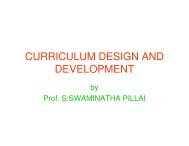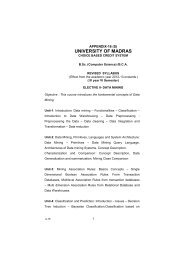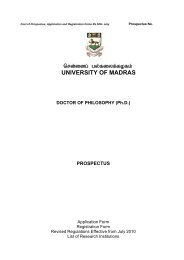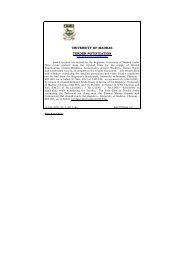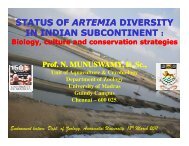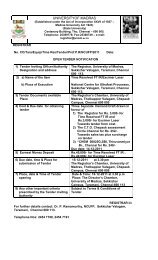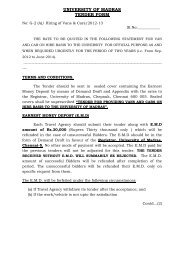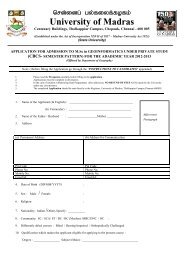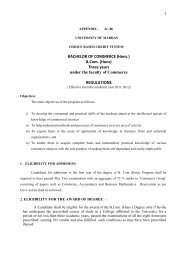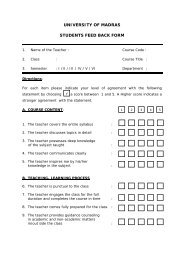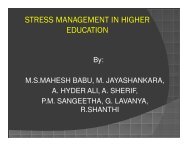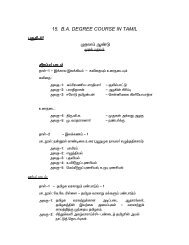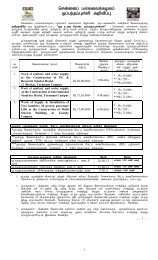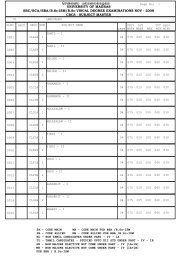(5 year Integrated) Degree Course under CBCS - University of Madras
(5 year Integrated) Degree Course under CBCS - University of Madras
(5 year Integrated) Degree Course under CBCS - University of Madras
- No tags were found...
Create successful ePaper yourself
Turn your PDF publications into a flip-book with our unique Google optimized e-Paper software.
1. (a) Those who have not studied Tamil up to XII Std. and taken a non-Tamillanguage <strong>under</strong> Part-I shall take Tamil comprising <strong>of</strong> two courses (level will be at 6 thstandard)(b) Those who have studies Tamil up to XII Std. and taken a non-Tamillanguage <strong>under</strong> Part-I shall take Advanced Tamil comprising <strong>of</strong> two courses.(c) Other who do not come <strong>under</strong> a + b can choose non-major electivecomprising <strong>of</strong> two courses.2. Skill based subjects (Elective) (S<strong>of</strong>t Skills)3. Environmental Studies4. Value EducationPART-VExtension ActivitiesEXTENSION SERVICE (Part-V)A candidate shall be awarded a maximum <strong>of</strong> 1 credit for Extension Service.All the students shall have to enroll for NSS / NCC / NSO (Sports & Games) Rotract / YouthRed Cross or any other service organizations in the College and shall have to' put in compulsoryminimum attendance <strong>of</strong> 40 hours which shall he duly certified by the Principal <strong>of</strong> the Collegebefore 31st March in a <strong>year</strong>. If a student LACKS 40 HOURS ATTENDANCE in the First Year,he/she shall have to compensate the same during the subsequent <strong>year</strong>s.Students those who complete minimum attendance <strong>of</strong> 40 hours in One Year will get HALFCREDIT and those who complete the attendance <strong>of</strong>80 or more hours in Two Years will get ONECREDIT. Literacy and population Education Field Work shall be compulsory components in theabove extension service activities.4
S.NOPARTCOURSECOMPONENTSNAME OF COURSEFIRST SEMESTERINST. HOURS/WKCREDITSEXAMDURATION HRSMAXMARKS1. I Language 6 3 3 25 752. II English (Incl. Skill based Subject) 6 3 3 25 753. III Core I Financial Accounting 5 4 3 25 754. III Core II Principles <strong>of</strong> Management 5 4 3 25 755. III Allied I Indian Economy 6 5 3 25 756. IV Skill based Subject(English Dept) - 3 3 25 757. Non-Tamil Students: Tamil (VI Std)Tamil Students :Non-Major Elective *2 2 3 25 75S.NOPARTCOURSECOMPONENTSNAME OF COURSESECOND SEMESTER30 24INST. HOURS/WKCREDITSEXAMDURATION HRSCIAEXTERNALMAXMARKS8. I Language 6 3 3 25 759. II English (Incl. Skill based Subject) 6 3 3 25 7510. III Core III Business Communication 5 4 3 25 7511. III Core IV Management Accounting 5 4 3 25 7512. III Allied II Managerial Economics 6 5 3 25 7513. IV Skill based Subject(English Dept) - 3 3 25 7514. Non-Tamil Students: Tamil (VI Std)Tamil Students :Non-Major Elective # 2 2 3 25 7530 24CIAEXTERNAL5
SEVENTH SEMESTERS.NOPARTCOURSECOMPONENTSNAME OF COURSEINST. HOURS/WKCREDITSEXAMDURATION HRSMAXMARKS41. III Core XXI Applied Operations Research 5 4 3 25 7542. III Core XXII Quality Management 5 4 3 25 7543. III Core XXIII Industrial Law 6 4 3 25 7544. III Core XXIV Strategic Management 6 4 3 25 7545. III Elective III Group A or Group B Elective 6 5 3 25 7546. IV 2 S<strong>of</strong>t Skill 2 2 3 25 7530 23CIAEXTERNALEIGHTH SEMESTERS.NOPARTCOURSECOMPONENTSNAME OF COURSEINST. HOURS/WKCREDITSEXAMDURATION HRSMAXMARKS47. III Core XXV Consumer Behaviour 5 4 3 25 7548. III Core XXVI Project Management 5 4 3 25 7549. III Elective IV Group A or Group B Elective 6 5 3 25 7550. III Core XXVII Project 6 3 25 7551. IV 2 S<strong>of</strong>t Skill 2 2 3 25 7521CIAEXTERNALTotal Credits at the End <strong>of</strong> 4 <strong>year</strong>s = 142 + 23 + 21 = 186 credits8
NINTH SEMESTERS.NOPARTCOURSECOMPONENTSNAME OF COURSEINST. HOURS/WKCREDITSEXAMDURATION HRSMAXMARKS53. III Core Retail Management 6 4 3 25 75XXVIII54. III Core XXIX Customer Relationship Management 6 4 3 25 7555. III Core XXX Human Resources Development 6 4 3 25 7556. III Core XXXI Knowledge Management 5 4 3 25 7557. III Core XXXII Services Marketing 5 4 3 25 7558. IV 2 S<strong>of</strong>t Skill 2 2 3 25 7530 22CIAEXTERNALTENTH SEMESTERS.NOPARTCOURSECOMPONENTSNAME OF COURSEINST. HOURS/WKCREDITSEXAMDURATION HRSMAXMARKS59. III Core Performance Management 5 4 3 25 75XXXIII60. III Elective V Group A or Group B Elective 6 5 3 25 7561. III Elective Group A or Group B Elective 6 5 3 25 75VI62. III Core Project 8 3 25 75XXXIV63. IV 2 S<strong>of</strong>t Skill 2 2 3 25 7524CIAEXTERNALTotal Credits at the End <strong>of</strong> 5 <strong>year</strong>s = 186 + 22 + 24 = 232 credits9
GROUP A – FINANCIAL SERVICESLIST OF ELECTIVES1. BANKING2. INSURANCE3. SECURITY ANALYSIS AND PORTFOLIO MANAGEMENT4. DERIVATIVES MANAGEMENT5. TAX MANAGEMENT6. MERCHANT BANKING AND FINANCIAL SERVICESGROUP B – LOGISTICS AND SUPPLY CHAIN MANAGEMENT1. INTERNATIONAL TRANSPORTATION SYSTEMS2. INDIA’S FOREIGN TRADE AND POLICY3. EXPORT IMPORT DOCUMENTATION AND PROCEDURES4. LOGISTICS AND MANAGING THE SUPPLY CHAIN5. INTERNATIONAL TRANSPORTATION LAW6. TRANSPORT ECONOMICS· THE SYLLABUS FOR THE FIRST YEAR ALONE IS FURNISHED.6. SCHEME OF EXAMINATION:Scheme <strong>of</strong> Examination shall be as given belowPART-ILanguagePART-IIEnglishPART-IIICore subject :<strong>Course</strong> ComponentName <strong>of</strong> the courseInst. HourCreditsExamHoursExt.markMax. MarksInt.markTotal75 25 10075 25 10075 25 100Core Subject 75 25 100Allied Subject 75 25 10010
PART – IV1. (a) Those who have notstudied Tamil up to XII Std. and taken a Non-Tamil Language <strong>under</strong> Part-I shall take Tamilcomprising <strong>of</strong> two course (level will be at 6 thStandard).(b) Those who have studies Tamil upto XII Std. and taken a Non-Tamil Language<strong>under</strong> Part-I shall take Advanced Tamilcomprising <strong>of</strong> two courses.(c) Others who do not come <strong>under</strong> a +b can choose non-major elective comprising <strong>of</strong>two courses.2*Skill based subjects(Elective) – (S<strong>of</strong>t Skill)The following procedure is to be followed for Internal Marks:Theory Papers: Internal MarksTests (2out <strong>of</strong> 3)Attendance*SeminarsAssignment10 marks5 marks5 marks5 marks----25 marks----7. REQUIREMENTS FOR PROCEEDING TO SUBSEQUENT SEMESTERS:(i) Candidates shall register their names for the First Semester Examination after the admissionin the <strong>Course</strong>.(ii) Candidates shall/be permitted to proceed from the First Semester up to Final Semesterirrespective <strong>of</strong> their failure in any <strong>of</strong> the Semester Examinations subject to the condition that thecandidates should register for all the arrear subjects <strong>of</strong> earlier semesters along with current(subsequent) Semester subjects.(iii) Candidates shall be eligible to go to subsequent semester, only if they earn, sufficientattendance as prescribed therefore by the Syndicate from time to time, provided in case <strong>of</strong> acandidate earning less than 50% <strong>of</strong> attendance in anyone <strong>of</strong> the semesters due to anyextraordinary circumstance such as medical grounds, such candidates who shall produce MedicalCertificate issued by the Authorised Medical Attendant (AMA), duly certified by the Principal <strong>of</strong>the College, shall be permitted to proceed to the next semester and to complete the course <strong>of</strong>study. Such candidates shall have to repeat the missed Semester by rejoining after completion <strong>of</strong>11
9. CLASSIFICATION OF SUCCESSFUL CANDIDATES:For Bachelor <strong>of</strong> Management (BM)PART – I TAMIL/OTHER LANGUAGES:TAMIL/OTHER LANGUAGES OTIIER THAN ENGLISH: Successful candidatespassing the examinations for the Language and securing the marks (i) 60 percent andabove and (ii) 50 percent and above but below 60 percent in the aggregate shall bedeclared to have passed the examination in the FIRST and SECOND Class respectively.All other successful candidates shall be declared to have passed the examination in theTHIRD Class.PART – II ENGLISH:ENGLISH: Successful candidates passing the examinations for English and securing themarks (i) 60 percent and above and (ii) 50 percent and above but below 60 percent in theaggregate shall be declared to have passed the examination in the FIRST arid SECONDClass respectively. All other successful candidates shall be declared to have passed theexamination in the THIRD Class.PART - III CORE SUBJECTS, ALLIED SUBJECTS, AND PROJECT/ELECTIVES:Successful candidates passing the examinations for Part-III <strong>Course</strong>s together and securingthe marks (i),60 percent and above (ii) 50 percent and above but below 60 percent in theaggregate <strong>of</strong> the marks prescribed for the Part-III <strong>Course</strong>s together shall be declared tohave passed the examination in the FIRST and SECOND Class respectively. All othersuccessful candidates shall be declared to have passed the examinations in the THIRDClass. .PART-IV (consisting <strong>of</strong> sub items 1 (a), (b) & (c), 2, 3 and 4) as furnished in the Regulations 4Part-IV supra.PART -V EXTENSION ACTIVITIES:Successful Candidates earning a minimum <strong>of</strong> Half Credit or a maximum <strong>of</strong> One CreditSHALL NOT BE taken into consideration for Classification / Ranking / Distinction.For Bachelor <strong>of</strong> Applied Management (BAM)Successful candidates securing not less than 75 percent in the aggregate <strong>of</strong> the marks <strong>of</strong> all thecourses prescribed for the entire FOUR <strong>year</strong>s shall be declared to have qualified for the <strong>Degree</strong> inFIRST CLASS WITH DISTINCTION.13
Successful candidates securing not less than 60 percent in the aggregate <strong>of</strong> the marks <strong>of</strong> all thecourses prescribed for the entire FOUR <strong>year</strong>s shall be declared to have qualified for the <strong>Degree</strong> inFIRST CLASS.Successful candidates securing not less than 50 percent in the aggregate <strong>of</strong> the marks <strong>of</strong> all thecourses prescribed for the entire FOUR <strong>year</strong>s shall be declared to have qualified for the <strong>Degree</strong> inSECOND CLASS.For Master <strong>of</strong> Applied Management (MAM)Successful candidates securing not less than 75 percent in the aggregate <strong>of</strong> the marks <strong>of</strong> all thecourses prescribed for the entire FIVE <strong>year</strong>s shall be declared to have qualified for the <strong>Degree</strong> inFIRST CLASS WITH DISTINCTION.Successful candidates securing not less than 60 percent in the aggregate <strong>of</strong> the marks <strong>of</strong> all thecourses prescribed for the entire FIVE <strong>year</strong>s shall be declared to have qualified for the <strong>Degree</strong> inFIRST CLASS.Successful candidates securing not less than 50 percent in the aggregate <strong>of</strong> the marks <strong>of</strong> all thecourses prescribed for the entire FIVE <strong>year</strong>s shall be declared to have qualified for the <strong>Degree</strong> inSECOND CLASS.10. GRADING SYSTEMThe Syndicate has approved the TANSCHE recommendations <strong>of</strong> Grading System in Under –graduate and Post-graduate <strong>Degree</strong> <strong>Course</strong>s <strong>under</strong> Choice Based Credit System in thecolleges with a modification in the Grading System for Five Year <strong>Integrated</strong> Programmes viz.the passing minimum <strong>of</strong> 40% for the first three <strong>year</strong>s and 50% for the fourth and fifth <strong>year</strong>.Marks and Grades for Bachelor <strong>of</strong> Management (BM):The following table gives the marks, grade points, letter grades and classification to indicate theperformance <strong>of</strong> the candidate.14
Conversion <strong>of</strong> Marks to Grade Points and Letter Grade (Performance in a <strong>Course</strong> / Paper)RANGE OF GRADE LETTER DESCRIPTIONMARKS POINTS GRADE90-100 9.0-10.0 O Outstanding80-89 8.0-8.9 D+ Excellent75-79 7.5-7.9 D Distinction70-74 7.0-7.4 A+ Very Good60-69 6.0-6.9 A Good50-59 5.0-5.9 B Average40-49 4.0-4.9 C Satisfactory00-39 0.0 U Re-appearABSENT 0.0 AAA ABSENTCi = Credits earned for coursei in any semester.Gi = Grade Point obtained for course i in any semester.nrefers to the semester in which such courses were credited.For a Semester:GRADE POINT AVERAGE [GPA] = ∑i Ci Gi / ∑i CiSum <strong>of</strong> the multiplication <strong>of</strong> grade points by the credits <strong>of</strong> the coursesGPA = ----------------------------------------------------------------------------------Sum <strong>of</strong> the credits <strong>of</strong> the courses in a semesterFor the entire programme:CUMULATIVE GRADE POINT AVERAGE [CGPA] = ∑n∑i CniGni /∑n∑i CniSum <strong>of</strong> the multiplication <strong>of</strong> grade points by the credits <strong>of</strong> the entire programmeCGPA= -----------------------------------------------------------------------------------------------Sum <strong>of</strong> the credits <strong>of</strong> the courses <strong>of</strong> the entire programme15
CGPA GRADE CLASSIFICATION OF FINALRESULT9.5-10.0 O+ First Class - Exemplary *9.0 and above but below 9.5 O8.5 and above but below 9.0 D++ First Class with Distinction *8.0 and above but below 8.5 D+7.5 and above but below 8.0 D7.0 and above but below 7.5 A++6.5 and above but below 7.0 A+6.0 and above but below 6.5 AFirst Class5.5 and above but below 6.0 B+ Second Class5.0 and above but below 5.5 B4.5 and above but below 5.0 C+ Third Class4.0 and above but below 4.5 C0.0 and above but below 4.0 U Re-appear*The candidates who have passed in the first appearance and within the prescribed semester <strong>of</strong>the UG Programme (Major, Allied and Elective courses alone) are eligible.Marks and Grades for Bachelor <strong>of</strong> Applied Management (BAM) & Master <strong>of</strong> AppliedManagement (MAM):The following table gives the marks, grade points, letter grades and classification to indicate theperformance <strong>of</strong> the candidate.Conversion <strong>of</strong> Marks to Grade Points and Letter Grade (Performance in a Paper /<strong>Course</strong>)RANGE OF GRADE LETTER DESCRIPTIONMARKS POINTS GRADE90-100 9.0-10.0 O Outstanding80-89 8.0-8.9 D+ Excellent75-79 7.5-7.9 D Distinction70-74 7.0-7.4 A+ Very Good60-69 6.0-6.9 A Good50-59 5.0-5.9 B Average00-49 0.0 U Re-appearABSENT 0.0 AAA ABSENT16
Ci = Credits earned for course i in any semester.Gi = Grade Point obtained for course i in any semester.nrefers to the semester in which such courses were credited.For a Semester:GRADE POINT AVERAGE [GPA] = ∑i Ci Gi / ∑i CiSum <strong>of</strong> the multiplication <strong>of</strong> grade points by the credits <strong>of</strong> the coursesGPA = ----------------------------------------------------------------------------------Sum <strong>of</strong> the credits <strong>of</strong> the courses in a semesterFor the entire programme:CUMULATIVE GRADE POINT AVERAGE [CGPA] = ∑n∑i CniGni /∑n∑i CniSum <strong>of</strong> the multiplication <strong>of</strong> grade points by the credits <strong>of</strong> the entire programmeCGPA= -----------------------------------------------------------------------------------------------Sum <strong>of</strong> the credits <strong>of</strong> the courses <strong>of</strong> the entire programmeCGPA GRADE CLASSIFICATION OF FINALRESULT9.5-10.0 O+ First Class - Exemplary *9.0 and above but below 9.5 O8.5 and above but below 9.0 D++ First Class with Distinction *8.0 and above but below 8.5 D+7.5 and above but below 8.0 D7.0 and above but below 7.5 A++6.5 and above but below 7.0 A+6.0 and above but below 6.5 AFirst Class5.5 and above but below 6.0 B+ Second Class5.0 and above but below 5.5 B0.0 and above but below 5.0 U Re-appear* The candidates who have passed in the first appearance and within the prescribed semester<strong>of</strong> the PG Programme ( Core, Elective, Non-major Electives and Extra-Disciplinary coursesalone) are eligible.17
11. RANKING:Candidates who pass all the examinations prescribed for the <strong>Course</strong> in the FIRST APPEARANCEITSELF ALONE are eligible for Ranking/Distinction.Provided in the case <strong>of</strong> Candidates who pass all the examinations prescribed for the <strong>Course</strong> with abreak in the First Appearance due to the reasons as furnished in the Regulations <strong>under</strong>REQUIREMENTS FOR PROCEEDING TO SUBSEQUENT SEMESTER are only eligible forClassification.12. QUESTION PAPER PATTERNTotal Marks for each subject 100 Marks<strong>University</strong> Exam 75 MarksInternal Assessment 25 MarksDuration: 3 Hours Max. Marks: 100Part A - 10 out <strong>of</strong> 12 questions (10X 1 = 10)Part B – 5out <strong>of</strong> 7 questions (5 X 5 = 25)Part C 1 question (Case Study or Problem) is Compulsory3 out <strong>of</strong> remaining 4 questions (4 X 10= 40)**************18
APPENDIX – 22(S)UNIVERSITY OF MADRASMASTER OF APPLIED MANAGEMENTCHOICE BASED CREDIT SYSTEMSYLLABUS(w.e.f. 2013-2014)FINANCIAL ACCOUNTING (Core)UNIT IIntroduction: Meaning and Scope <strong>of</strong> Accounting – Basic Accounting Concepts and Conventions– Objectives <strong>of</strong> Accounting – Accounting Transactions – Double Entry Bookkeeping – Journal,Ledge, Trial Balance – Preparation <strong>of</strong> Cash Book.UNIT IIFinal Accounts: Meaning – Preparation <strong>of</strong> Final Accounts – Trading Account – Pr<strong>of</strong>it and LossAccount – Balance Sheet – Distinction between Trial Balance and Balance Sheet – AdjustmentEntries.UNIT IIIAverage Due Date – Meaning – Practical Uses <strong>of</strong> Average Due Date – Basic Problems inAverage Due DateClassification <strong>of</strong> Errors – Rectification <strong>of</strong> Errors – Preparation <strong>of</strong> Suspense AccountBank Reconciliation Statement.UNIT IVDepreciation: Meaning – Cause – Types – Straight Line Method – Written Down Value Method– Insurance Policy Method – Sinking Fund Method and Annuity Method – Insurance Claims –Average Clause (Loss <strong>of</strong> Stock and Loss <strong>of</strong> Pr<strong>of</strong>it)UNIT VSingle Entry: Meaning – Features – Defects – Differences between Single Entry and DoubleEntry System- Statement <strong>of</strong> Affairs Method – Conversion Method.Reference Books1. Dhamija, S., Financial Accounting For Managers, Pearson, 2012.2. Maheshwari, S.N., Maheshwari, S. and Maheshwari, S.K., Financial Accounting, 5 thEdition, Vikas Publishing House, 2010.3. Narayanaswamy, R., Financial Accounting, 4 th Edition, PHI Learning, 2011.4. Stice, E.S. and Stice, J., Financial Accounting: Reporting and Analysis, 7 th Edition,Cengage Learning, 2006.5. Tulsian, P.C., Financial Accounting, S.Chand, 2011.19
UNIT VModern Forms <strong>of</strong> Communication: Fax – Email – Video Conferencing – Internet – Websites andtheir use in Business.Reference Books1. American Management Association, the AMA Handbook <strong>of</strong> Business Writing: theUltimate guide to Style, Grammar, Usage, Punctuation, Construction and Formatting,2010.2. Bovee, C., Thill, J.V. and Chatterjee, A., Business Communication Today, Pearson, 10 thEdition, 2011.3. Chaney, L. and Martin, J., Intercultural Business Communication, Pearson, 4 th Edition,2008.4. Chaturvedi, Business Communication, Pearson, 2 nd Edition, 2011.5. Jain, N. and Mukherjee, S., Effective Business Communication, Tata McGrawHillEducation Pvt. Ltd., 2012.6. Locker, Business Communication: Building Critical Skills, Tata McGrawHill EducationPvt. Ltd., 3 rd Edition, 2006.7. Murphy, H., Hildebrandt, H. and Thomas, J., Effective Business Communication, TataMcGrawHill Education Pvt. Ltd., 7 th Edition, 2008.8. Raman, M. and Singh, P., Business Communication, Oxford <strong>University</strong> Press, 2006.Taylor, S., Communication for Business, Pearson, 4 th Edition, 2010MANAGEMENT ACCOUNTING (Core)UNIT IIntroduction: Management Accounting: Meaning – Nature – Scope and Function – Need –Importance and Limitations – Management Accounting vs. Cost Accounting – ManagementAccounting vs. Financial AccountingUNIT IIAnalysis and Interpretation <strong>of</strong> Financial Statements: Nature – Objectives – Essentials – Tools –Methods – Comparative Statements – Common Size Statement and Trend Analysis.UNIT IIIRatio Analysis: Interpretation – Benefits and Limitations – Classification <strong>of</strong> Ratios: Liquidity,Pr<strong>of</strong>itability, Turnover, Capital Structure and Leverage.UNIT IVFunds Flow and Cash Flow Analysis – Budgets and Budgetary Control: Meaning – Objectives –Merits and Dements.22
UNIT VMarginal Costing (excluding decision making – Absorption Costing ad Marginal Costing – CVPAnalysis.Reference Books1. Atkinson, A., Kaplan, R.S., Young, M., Matsumura, E.M., and Arunkumar G.,Management Accounting, Pearson, 2009.2. Gupta, A., Financial Accounting for Management: An Analytical Perspective, 4 th Edition,Pearson, 2012.3. Horngren, C.T., Sundem, G.L., Stratton, W.O., Burgstahler, D. and Schatzberg, J., 14 thEdition, Pearson, 2008.4. Khan, M.Y. and Jain, P.K., Management Accounting: Text , Problems and Cases, 5 thEdition, Tata McGraw Hill Education Pvt. Ltd., 2009.5. Noreen, E., Brewer, P. and Garrison, R., Managerial Accounting for Managers, 13 thEdition, Tata McGraw-Hill Education Pvt. Ltd., 2009.6. Rustagi, R. P., Management Accounting, 2 nd Edition, Taxmann Allied Services Pvt. Ltd,2011.MANAGERIAL ECONOMICS (Allied)UNIT IIntroduction: Nature and Scope <strong>of</strong> Managerial Economics – Definition <strong>of</strong> Economics – ImportantConcepts <strong>of</strong> Economics – Relationship between Micro, Macro and Managerial Economics –Nature and Scope – Objectives <strong>of</strong> FirmUNIT IIDemand Analysis: Theory <strong>of</strong> Consumer Behaviour – Marginal Utility Analysis – IndifferenceCurve Analysis – Meaning <strong>of</strong> Demand – Law <strong>of</strong> Demand – Types <strong>of</strong> Demand – Determinants <strong>of</strong>Demand – Elasticity <strong>of</strong> Demand – Demand ForecastingUNIT IIIProduction and Cost Analysis: Production – Factors <strong>of</strong> Production – Production Function –Concept – Law <strong>of</strong> Variable Proportion – Law <strong>of</strong> Return to Scale and Economies <strong>of</strong> Scale – CostAnalysis – Different Cost Concepts – Cost Output Relationship – Short run and Long run –Revenue Curves <strong>of</strong> Firms – Supply AnalysisUNIT IVPricing Methods and Strategies: Objectives – Factors – General Consideration <strong>of</strong> Pricing –Methods <strong>of</strong> Pricing – Dual Pricing – Price DiscriminationUNIT VMarket Classification: Perfect Competition – Monopoly – Monopolistic Competition – Duopoly– Oligopoly23
Reference Books1. Damodaran, S., Managerial Economics, 2 nd Edition, Oxford <strong>University</strong> Press, 2011.2. Dean, J., Managerial Economics, PHI Learning Pvt. Ltd., 2009.3. Dwivedi, D.N., Managerial Economics, Vikas Publishing House, 2011.4. Froeb, L.M., McCann, B.T., Managerial Economics: A Problem Solving Approach,South Western, 2008.5. Hirschey, M., Managerial Economics: An Integrative Approach, South Western, 2010.6. Keat, P.G., Young, P. and Banerjee, S., Managerial Economics: Economics Tools forToday’s Decision Makers, 6 th Edition, Pearson, 2010.7. Salvatore, D. and Srivastava, R., Managerial Economics: Principles and WorldwideApplications, 7th Edition, Oxford <strong>University</strong> Press, 2012.8. Thomas, C.R., Maurice, C. and Sarkar, S., Managerial Economics, 9 th Edition, TataMcGraw-Hill Education Pvt. Ltd., 2010.***************24



